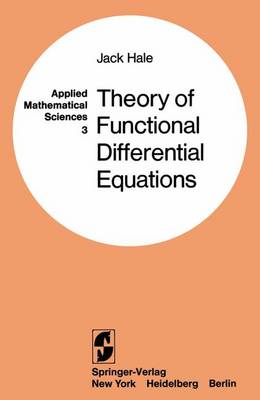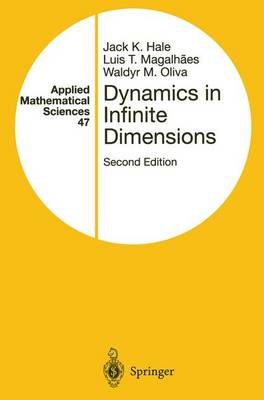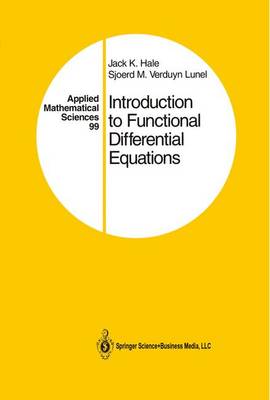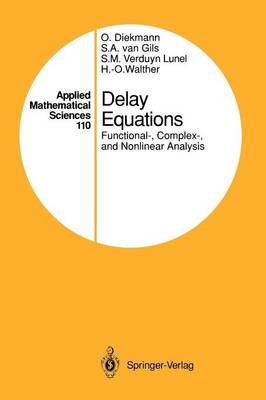Applied Mathematical Sciences
4 primary works
Book 3
It is hoped that these notes will serve as an introduction to the subject of functional differential equations. The topics are very selective and represent only one particular viewpoint. Complementary material dealing with extensions of closely related topics are given in the notes at the end. A short bibliography is appended as source material for further study. The author is very grateful to the Mathematics Department at UCLA for having extended the invitation to give a series of lectures on functional differ- ential equations during the Applied Mathematics Year, 1968-1969. The extreme interest and sincere criticism of the members of the audience were a constant source of inspiration in the preparation of the lectures as well as the notes. Except for Sections 6, 32, 33, 34 and some other minor modifications, the notes represent the material covered in two quarters at UCLA. The author wishes to thank Katherine McDougall and Sandra Spinacci for their excellent preparation of the text. The author is also indebted to Eleanor Addison for her work on the drawings and to Dr. H. T. Banks for his careful proofreading of this material. Jack K.
Hale Providence March 4, 1971 v TABLE OF CONTENTS 1. INTRODUCTION *****.*..**.*********.***..*.******.******.**.**.***.*** 1 2 * A GENERAL INITIAL VALUE PROBLEM 11 3 * EXISTENCE 13 4. CONTINUATION OF SOLUTIONS 16 CONTINUOUS DEPENDENCE AND UNIQUENESS 21 5.
Hale Providence March 4, 1971 v TABLE OF CONTENTS 1. INTRODUCTION *****.*..**.*********.***..*.******.******.**.**.***.*** 1 2 * A GENERAL INITIAL VALUE PROBLEM 11 3 * EXISTENCE 13 4. CONTINUATION OF SOLUTIONS 16 CONTINUOUS DEPENDENCE AND UNIQUENESS 21 5.
Book 47
Dynamics in Infinite Dimensions
by Jack K. Hale, Luis T. Magalhaes, and Waldyr Oliva
Published 1 January 2002
State-of-the-art in qualitative theory of functional differential equations; Most of the new material has never appeared in book form and some not even in papers; Second edition updated with new topics and results; Methods discussed will apply to other equations and applications
Book 99
Introduction to Functional Differential Equations
by Jack K. Hale and Sjoerd M. Verduyn Lunel
Published 14 October 1993
The present book builds upon an earlier work of J. Hale, "Theory of Func tional Differential Equations" published in 1977. We have tried to maintain the spirit of that book and have retained approximately one-third of the material intact. One major change was a complete new presentation of lin ear systems (Chapters 6~9) for retarded and neutral functional differential equations. The theory of dissipative systems (Chapter 4) and global at tractors was completely revamped as well as the invariant manifold theory (Chapter 10) near equilibrium points and periodic orbits. A more complete theory of neutral equations is presented (see Chapters 1, 2, 3, 9, and 10). Chapter 12 is completely new and contains a guide to active topics of re search. In the sections on supplementary remarks, we have included many references to recent literature, but, of course, not nearly all, because the subject is so extensive. Jack K. Hale Sjoerd M. Verduyn Lunel Contents Preface............................................................ v Introduction . . . . . . . . . . . . . . . . . . . . . . . . . . . . . . . . . . 1 . . . . . . . . . . . . . . . . . . . . 1. Linear differential difference equations . . . . . . . . . . . . . . 11 . . . . . . 1.1 Differential and difference equations. . . . . . . . . . . . . . . . . . . . 11 . . . . . . . . 1.2 Retarded differential difference equations. . . . . . . . . . . . . . . . 13 . . . . . . . 1.3 Exponential estimates of x( c,f) . . . . . . . . . . . . . . . . . . . . . 15 . . . . . . . . . . 1.4 The characteristic equation . . . . . . . . . . . . . . . . . . . . . . . . 17 . . . . . . . . . . . . 1.5 The fundamental solution. . . . . . . . . . . . . . . . . . . . . . . . . . 18 . . . . . . . . . . . . 1.6 The variation-of-constants formula............................. 23 1. 7 Neutral differential difference equations . . . . . . . . . . . . . . . . . 25 . . . . . . . 1.8 Supplementary remarks. . . . . . . . . . . . . . . . . . . . . . . . . . . 34 . . . . . . . . . . . . . 2. Functional differential equations: Basic theory . . . . . . . . 38 . . 2.1 Definition of a retarded equation. . . . . . . . . . . . . . . . . . . . . . 38 . . . . . . . . . 2.2 Existence, uniqueness, and continuous dependence . . . . . . . . . . 39 . . . 2.3 Continuation of solutions . . . . . . . . . . . . . . . . . . . . . . . . . . 44 . . . . . . . . . . . .
Book 110
Delay Equations
by Odo Diekmann, Stephan A. van Gils, Sjoerd M. Verduyn Lunel, and Hans-Otto Walther
Published 9 May 1995
The aim here is to provide an introduction to the mathematical theory of infinite dimensional dynamical systems by focusing on a relatively simple - yet rich - class of examples, delay differential equations. This textbook contains detailed proofs and many exercises, intended both for self-study and for courses at graduate level, as well as a reference for basic results. As the subtitle indicates, this book is about concepts, ideas, results and methods from linear functional analysis, complex function theory, the qualitative theory of dynamical systems and nonlinear analysis. The book provides the reader with a working knowledge of applied functional analysis and dynamical systems.



